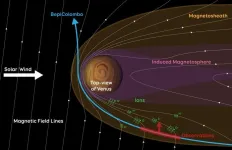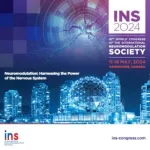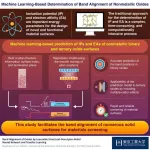BepiColombo spies escaping oxygen and carbon in unexplored region of Venus’s magnetosphere
2024-04-12
(Press-News.org)
A fleeting visit of the ESA/JAXA BepiColombo mission to Venus has revealed surprising insights into how gases are stripped away from the upper layers of the planet’s atmosphere.
Detections in a previously unexplored region of Venus’s magnetic environment show that carbon and oxygen are being accelerated to speeds where they can escape the planet’s gravitational pull. The results have been published today in the journal Nature Astronomy.
Lina Hadid, CNRS researcher at the Plasma Physics Laboratory (LPP) and lead author of the study said: “This is the first time that positively charged carbon ions have been observed escaping from Venus’s atmosphere. These are heavy ions that are usually slow moving, so we are still trying to understand the mechanisms that are at play. It may be that an electrostatic ‘wind’ is lifting them away from the planet, or they could be accelerated through centrifugal processes.”
Unlike Earth, Venus does not generate an intrinsic magnetic field in its core. Nonetheless, a weak, comet-shaped ‘induced magnetosphere’ is created around the planet by the interaction of charged particles emitted by Sun (the solar wind) with electrically charged particles in Venus’s upper atmosphere. Draped around the magnetosphere is a region called the ‘magnetosheath’ where the solar wind is slowed and heated.
On 10 August 2021, BepiColombo passed by Venus to slow down and adjust course towards its final destination of Mercury. The spacecraft swooped up the long tail of Venus’s magnetosheath and emerged through the nose of the magnetic regions closest to the Sun. Over a 90-minute period of observations, BepiColombo’s instruments measured the number and mass of charged particles it encountered, capturing information about the chemical and physical processes driving atmospheric escape in the flank of the magnetosheath.
Early in its history, Venus had many similarities to Earth, including significant amounts of liquid water. Interactions with the solar wind have stripped away the water, leaving an atmosphere composed mainly of carbon dioxide and smaller amounts of nitrogen and other trace species. Previous missions, including NASA’s Pioneer Venus Orbiter and ESA’s Venus Express have made detailed studies of the type and quantity of molecules and charged particles that are lost into space. However, the missions’ orbital paths left some areas around Venus unexplored and many questions still unanswered.
Data for the study were obtained by BepiColombo’s Mass Spectrum Analyzer (MSA) and the Mercury Ion Analyzer (MIA) during the spacecraft’s second Venus flyby. The two sensors are part of the Mercury Plasma Particle Experiment (MPPE) instrument package, which is carried by Mio, the JAXA-led Mercury Magnetospheric Orbiter.
“Characterising the loss of heavy ions and understanding the escape mechanisms at Venus is crucial to understand how the planet’s atmosphere has evolved and how it has lost all its water,” said Dominique Delcourt, researcher at LPP and the Principal Investigator of the MSA instrument.
Europlanet’s SPIDER space weather modelling tools enabled the researchers to track how the particles propagated through the Venusian magnetosheath.
“This result shows the unique results that can come out of measurements made during planetary flybys, where the spacecraft may move through regions generally unreachable by orbiting spacecraft,” said Nicolas André, of the Institut de Recherche en Astrophysique et Planétologie (IRAP) and lead of the SPIDER service.
A fleet of spacecraft will investigate Venus over the next decade, including ESA’s Envision mission, NASA’s VERITAS orbiter and DAVINCI probe, and India’s Shukrayaan orbiter. Collectively, these spacecraft will provide a comprehensive picture of the Venusian environment, from the magnetosheath, down through the atmosphere to the surface and interior.
“Recent results suggest that the atmospheric escape from Venus cannot fully explain the loss of its historical water content. This study is an important step to uncover the truth about the historical evolution of the Venusian atmosphere, and upcoming missions will help fill in many gaps,” added co-author, Moa Persson of the Swedish Institute of Space Physics.
END
[Attachments] See images for this press release:

ELSE PRESS RELEASES FROM THIS DATE:
2024-04-12
Vancouver, BC – The International Neuromodulation Society (INS) announces its 16th Scientific World Congress in the breathtaking city of Vancouver, Canada, from May 11-16, 2024. This event, "Neuromodulation: Harnessing the Power of the Nervous System," is set to gather over 1,500 experts from over 40 countries –– with researchers presenting more than 460 abstracts –– all dedicated to advancing research, clinical application, and development in the field of neuromodulation.
This multidisciplinary program will draw clinicians, engineers, scientists, post-doctoral fellows, current students, and device manufacturers, and attendees ...
2024-04-12
The IOF Committee of Scientific Advisors (CSA) Medal of Achievement has been presented to Dr Patricia Clark at the World Congress on Osteoporosis, Osteoarthritis & Musculoskeletal Diseases (WCO-IOF-ESCEO 2024), being held in London, UK from April 11-14, 2024.
The CSA Medal of Achievement honours individuals who have significantly advanced the field of osteoporosis through their original and outstanding scientific contributions, and whose work has helped to increase understanding and awareness of osteoporosis. Candidates are nominated by members ...
2024-04-12
Today, the European Society for Clinical and Economic Aspects of Osteoporosis, Osteoarthritis and Musculoskeletal Diseases (ESCEO) and the International Osteoporosis Foundation (IOF) have awarded the ESCEO-IOF Pierre Delmas Medal to Professor Claudia Campusano, MD, MSc., Professor of Medicine and Endocrinology at the Faculty of Medicine, Universidad de los Andes in Santiago, Chile.
The ESCEO-IOF Pierre Delmas Medal was presented at the World Congress on Osteoporosis, Osteoarthritis and Musculoskeletal Diseases, taking place in London, UK from April 11 to 14, 2024. The award recognizes a researcher who has made outstanding ...
2024-04-12
The design and development of novel materials with superior properties demands a comprehensive analysis of their atomic and electronic structures. Electron energy parameters such as ionization potential (IP), the energy needed to remove an electron from the valence band maximum, and electron affinity (EA), the amount of energy released upon the attachment of an electron to the conduction band minimum, reveal important information about the electronic band structure of surfaces of semiconductors, insulators, and dielectrics. The accurate ...
2024-04-12
Scientists have discovered that a type of fat accumulates as tissue ages and that this accumulation can be reversed through exercise. Researchers from Amsterdam UMC, together with colleagues from Maastricht UMC+, analysed both mice and human tissue before and after exercise allowing them to draw this conclusion. The results are published today in Nature Aging.
"The idea that we could reverse aging is something that was long considered science fiction, but these findings do allow us to understand a lot more about the ...
2024-04-12
In October 2022, an international team of researchers, including Northwestern University astrophysicists, observed the brightest gamma-ray burst (GRB) ever recorded, GRB 221009A.
Now, a Northwestern-led team has confirmed that the phenomenon responsible for the historic burst — dubbed the B.O.A.T. (“brightest of all time”) — is the collapse and subsequent explosion of a massive star. The team discovered the explosion, or supernova, using NASA’s James Webb Space Telescope (JWST).
While this discovery solves one mystery, another mystery deepens.
The researchers ...
2024-04-12
An international research team led by a researcher from the University of Vienna has for the first time directly detected stellar winds from three Sun-like stars by recording the X-ray emission from their astrospheres, and placed constraints on the mass loss rate of the stars via their stellar winds. The study is currently published in Nature Astronomy.
Astrospheres, stellar analogues of the heliosphere that surrounds our solar system, are very hot plasma bubbles blown by stellar winds into the interstellar medium, a space filled with gas and dust. The ...
2024-04-12
Whether by way of Attenborough, Disney or National Geographic, the iconic scene is familiar to many. The ground trembles and clouds of dust swirl as enormous hordes of large animals thunder across the African savanna, cross rivers en masse and are picked off by lions, hyena and crocodiles. The annual migration of 1.3 million wildebeest through Tanzania’s Serengeti and Kenya’s Masai Mara attracts hundreds of thousands of tourists, and the phenomenon has put the Serengeti on UNESCO's list of World Heritage sites. Besides its majestic sight, the migration of this emblematic species ...
2024-04-12
A Dartmouth-led study suggests that people who frequently consume seafood may face an increased risk of exposure to PFAS, the family of ubiquitous and resilient human-made toxins known as "forever chemicals."
The findings stress the need for more stringent public health guidelines that establish the amount of seafood people can safely consume to limit their exposure to perfluoroalkyl and polyfluoroalkyl substances, the researchers report in the journal Exposure and Health. This need is especially urgent for coastal regions such as New England where a legacy of industry and PFAS pollution bumps up against a cultural predilection for fish, the authors write.
"Our recommendation ...
2024-04-12
Embargoed until 8:30 a.m. Friday, 12 April, 2024 Central European Summer Time or GMT +2
12 April, 2024, Prague, Czech Republic—Re-perfusing the lungs of an organ donor after the heart has irreversibly stopped beating with a technique called normothermic regional perfusion (TA-NRP) could potentially increase the number of patients receiving lung transplants, according to researchers at the Annual Meeting and Scientific Sessions of the International Society for Heart and Lung Transplantation (ISHLT) in Prague.
TA-NRP uses a machine to pass blood through a donor’s abdomen and chest after the heart has irreversibly stopped beating (called ...
LAST 30 PRESS RELEASES:
[Press-News.org] BepiColombo spies escaping oxygen and carbon in unexplored region of Venus’s magnetosphere




